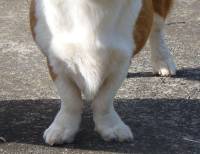Judging a Terrier
 Bedlington & Dandie Dinmont Terriers
Bedlington & Dandie Dinmont Terriers
Today's terrier breed standards were based on their specialized ability to dig. According to the prey the dog was hunting and the terrain in which he hunted, the construction of the terrier was selected and evolved accordingly. This section describes how and why the terriers' construction has been adapted from a normally constructed dog, to one with this specialized digging ability.
A Functional Approach
Between modern insecticides and abolition of many traditional hunting practices, terrier work is now almost redundant. So it is vital for those interested in breeding and/or judging modern terrier breeds to understand how and why their construction developed. This is described in detail in the Historical Function of Terriers.
The previous descriptions contained on the unique pages of each particular breed on this website have been divided into the regions of the terrier's historical development. But in this section Terriers are separated by their function reflected by their leg length. The long legged terriers were developed for work above the ground and the short legged terriers were developed for work beneath the ground. For example, in this 1890's painting of a Bedlington and Dandie Dinmont Terrier, you can see how because of function, one breed became two based on differing leg lengths.
 West Highland White Terrier
West Highland White Terrier
With shorter legged terriers, the depth of the chest requires special consideration. That is why they are categorised into the two different sections - the short legged terriers that primarily work beneath the ground and the the long legged terriers that primarily work above the ground, but have been adapted so they are still capable of entering an underground burrow.
Note the Bull Terrier breeds (Staffordshire Bull Terrier, American Staffordshire Terrier, Bull Terrier and Mini Bull Terrier) are considered separately.
Judging a Short Legged Terrier
 Judging a short legged terrier
Judging a short legged terrier
When judging, although all these Breed Standards except the Glen of Imaal ask for front legs to be as straight as possible, a slight amount of bow or outwards turn of the front feet, in the Scotty, Dandie Dinmont, and Skye is tolerated. But any amount of bow in the front legs or the front feet turning out in any other terriers like the Sealyham is undesirable.
Having said that, the bowed front legs are not to be confused with the breed standard of the Cairn that allows the front feet to turn out a little. Like the Staffordshire Bull Terrier, this slight turn out of the feet in the Cairn is from the pastern only and is allowed so the dog can balance. This has nothing to do with the front construction of a terrier adapted for digging purposes or an incorrect bow in the front legs caused by excessive depth of chest[3].
Judging a Short Legged Terrier
 Achondroplasia or Dwarfism
Achondroplasia or Dwarfism
But excessive bow of the front legs can cause the front feet to turn out too much as shown. This is undesirable in any terrier and could indicate the presence of the genetic abnormality of achondroplasia or dwarfism[2].
So, it is extremely important that that breeders and judges always check the depth of chest of short legged terriers and look for legs as straight as possible. Because excessively deep chests can also cause this incorrect bow in the front legs[3].
References and Further Reading
Jane Harvey, DVD "Terriers Then & Now" (Rangeaire Vision 2002, 2004) ISBN 978-0-9804296-4-0
[3] Jane Harvey, "Incorrect Front Construction" in Lets Talk Terriers (Tracy Murphy, Dean Park NSW) Vol 2 No 2 2006 Pages 2-4